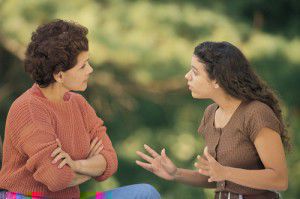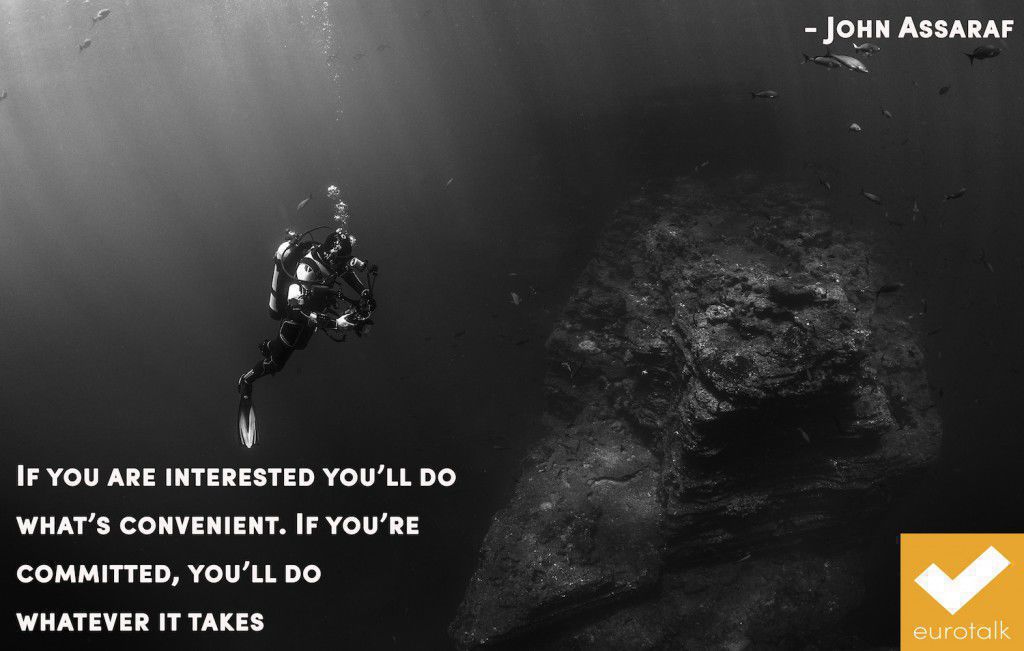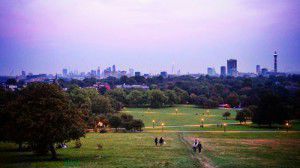Quote of the week: 13 Dec 2014
“If you are interested you’ll do what’s convenient. If you’re committed, you’ll do whatever it takes.” John Assaraf
For more like this, find us on Pinterest.
Embed This Image On Your Site (copy code below):
Why I’m learning Thai in January – a poem
Something a little different today, just because it’s Friday…
Like many of us, Steve will be taking on the uTalk challenge in January 2015, and he’s chosen to explain the reasons for his language choice in verse. As you do 😉
If you’d like to join Steve (in the uTalk language challenge, not the poetry), drop us an email with your chosen language over the next couple of weeks and we’ll let you know how it’s going to work. Good luck!
Last Monday I went into the EuroTalk office, had hardly taken off my hat
When Liz announced to all and sundry: ‘Now here’s a challenge and it’s no trap:
Pick any language from the uTalk App.
I don’t mind which, as long as you try;
You’ll have the month of January, no more,
To use the App and get damn good scores!’
OK, I thought, well … it’s got to be Thai.
Here goes, methinks: it’s a very fine tongue, and could just be a bit of fun!
I go there a lot, it’s lovely and hot, I like Bangkok, the people, the vibe,
But knowing no Thai is something I can’t hide.
It’s a bit of a challenge, it’s a question of pride
I’ll read a menu
In any venue
I’ll not freak out when someone phones
If I can only master those tones
That speakers of Thai use as a matter of course.
I’ll use the App to get damn good scores.
I won’t give up, I will not park it
I’ll have that chat with the guy at the market
To buy my stuff and interact.
I’ll learn some Thai from the uTalk App!
Steve
The importance of Body Language when learning a new language
Today we’re happy to welcome back Izabella Klein, who spent some time with us last year while she was translating the onebillion maths apps into Brazilian Portuguese. Izabella’s new post focuses on a language we all speak, even if we don’t realise it…
Starting next year I will go back to teaching English as a second language. In the meantime I am recalling all the grammar points, reminding myself what to do in a classroom, as well as emphasising the key points when learning a new language. During this process, I thought of myself as a linguist constantly studying new languages: either technical languages or a new language spoken elsewhere in the world.
This moment of reflection and remembrance made me realise in a more mature way how body language is not only important in daily conversation, but it is the ‘real universal language’, since it is the only language that in fact everyone in the world can use. So, it becomes really important when learning/teaching a new language. I would say it is the first key to follow into teaching any new language.
 For instance, how do we recognise body language? Probably when we realise when someone is sad or happy, thrilled or devastated just by their faces and body movements. So body language is when we can interpret without a word being said – only by our eyes observing someone using body language. Old black and white movies are great examples when we notice how they used much more body language than movies nowadays. No sound, no words, all they had were scenarios, costumes and body language to make people laugh or cry.
For instance, how do we recognise body language? Probably when we realise when someone is sad or happy, thrilled or devastated just by their faces and body movements. So body language is when we can interpret without a word being said – only by our eyes observing someone using body language. Old black and white movies are great examples when we notice how they used much more body language than movies nowadays. No sound, no words, all they had were scenarios, costumes and body language to make people laugh or cry.
Now think of an international film festival you’ve been to, or just any foreign movie you’ve watched one day, in a language you either don’t speak at all or at which you are still basic or intermediate level. If you got tired of reading the subtitles, or you’re a language geek like me, always trying to understand what people say even if it’s an unknown language, you had to go with ‘trying to figure it out’ by listening to the sound of the words said by the characters and observing the body language they were using while saying it.
So don’t go taking any conclusion in advance, thinking you will not be able to understand anything at all, just because you don’t speak the language. Relax and watch the movie, observe what the characters do. I bet you will understand more than you imagine and you will learn even if only a little bit of that language.
Meeting foreign people in person and socialising with them is also a great opportunity of observing and learning a new language and culture. We have such opportunities when we travel abroad, have a foreign friend coming over, when we chat with a friend via Skype or similar, or when we have a language teacher.
But if you don’t have those at the moment but you still want to learn, multimedias are really efficient not only for entertainment, but for education purposes as well. We are able to observe images, while we listen and even read. We use both our eyes and our ears; these senses, at the same time connected and alert, increase learning possibilities. And we see not only scenarios and costumes that help identify cultural aspects. We also see body language as a key to trying to figure out what is being said or even really understand what is being said, together with words that might sound familiar due to having the same linguistic routes as another language you already learnt.
Did you ever have a language teacher trying to introduce some new vocabulary in class, acting like a drama teacher, using a lot of mimes and weird sounds trying to make you understand the meaning of the new words? She was not just acting CRAZY, she was trying to make you learn like babies do, by observing. So, pay attention to body language, it will definitely help you learn other languages. As for me, I will probably take drama classes to help me improve my body language skills in class…
Izabella Klein
Why I’m learning German in January
In a few weeks, I’m taking on the uTalk challenge – using the app to see how much I can learn in the 31 days of January.
I’ve been trying to decide which language to go for; there wasn’t any particular one that I needed for a holiday or work trip, so I had the full choice of 100 languages in the app to pick from. Having the opportunity to learn something just for the pure fun of it is great, although 100 is a lot of options for someone as indecisive as I am.
My first thought was to learn Catalan, so I’m prepared for my next trip to Barcelona, whenever that may be. But as I already speak Spanish, it seemed like a bit of a cheat. Although there are significant differences between the two languages, on the whole they’re similar enough to give me an unfair advantage over my colleagues!
So then I decided to use the power of Facebook, and asked my friends which language they thought I should learn. I got various suggestions – Japanese, Navajo, Lithuanian, Welsh…
I was tempted by them all, but in the end I think I’ve finally made a decision. So this January, I’ll be having a go at German.
There were a few reasons for this. Firstly, I never got the chance to learn German at school, because we had to choose either Spanish or German. I’ve never regretted choosing Spanish, which I went on to study at A-Level and university, but from time to time I’ve wondered what might have happened if I’d gone for the other option.
Secondly, German looks quite tricky, and I figured if I was going to take on a challenge, I might as well do it properly. I’m a bit fascinated by the language, too, with its hugely long words; from what I can tell, you can come up with a word for just about anything by sticking others together. And it has some great proverbs.
Also, Germany’s close enough for me to pop over for a long weekend if I want to practise, whereas some of the other options, like Japanese and Navajo, are spoken a bit further afield. Maybe next year…
Finally, one of my favourite words is German. Backpfeifengesicht means ‘a face badly in need of a fist’. And as far as I’m concerned, a language that can come up with a word to describe that has to be worth a look.
Anyone want to join me?
Liz
10 reasons to visit… London
I’m really excited about this one, London is my absolute favourite city and not only because it has been my lovely home for more than a year but because it’s truly one of the best places in the world.
Here are 10 reasons you should choose London as your next destination for a city break or a longer vacation.
1. The people and the vibe
I’ve put these two reasons together because I think they are related to one another. The first thing that made me have the warmest feelings for this great city is the kindness and friendliness of the people. When I first came here I thought it is very endearing that people here say ‘thank you’, ‘sorry’, ‘I apologise’ as often as they can, and that matters more than you’d think when you are in a city with 8 million other people.
I promised I’d be specific so let’s get down to actual locations of things to see in London. Now, I won’t bore you with Big Ben and the London Eye… If you’ve never been here before, I suggest reserving a day just for the Central London attractions so you can tick them off your list, ’cause, you know, #BigBenSelfie.
2. Richmond
When you get there you’ll be in a different world. Richmond Park, the largest of the capital’s eight Royal Parks and the biggest enclosed space in London, is home to the beautiful Isabella Plantation, Pembroke Lodge and herds of Red and Fallow deer.
The city centre is very beautiful as well – take a walk near the river, the bridge and on the high street. If you are lucky to be there on a sunny day, have a look at the local farmers market, the lovely boat restaurants and terraces along the river.
3. Holland Park & Kyoto Garden
Holland Park is a district and a public park in the Royal Borough of Kensington and Chelsea, in central London. It has a reputation as an affluent and fashionable area, known for attractive large Victorian townhouses, and high-class shopping and restaurants. The park itself is very beautiful and quiet, with squirrels and peacocks walking around. Inside the park you can find the Kyoto Garden, which is a Japanese garden and can be described as an oasis of tranquility, where you can relax and watch the waterfalls and the rather large orange fish swimming in the pond.
4. Kensington Palace and Hyde Park
These two locations are close together so I reckon this would be the perfect place for spending a lovely relaxed day starting with brunch in one of Notting Hill Gate’s posh cafés and continuing with a walk to Kensington Palace and its amazingly beautiful gardens (no really, the Brits have a special talent when it comes to ridiculously good looking gardens). Passing this, you will find yourself in the biggest park in central London, Hyde Park.
5. Notting Hill Gate and Portobello market
Head to the famous Portobello Road Market for everything from antiques and vintage accessories to street food and fresh veg stalls. If you like walking around aimlessly in an unfamiliar area, I definitely recommend a walk on the streets of Notting Hill, to discover nice boutiques, cafés, restaurants and colourful houses. If you are there on the Sunday and Monday of the last weekend in August you can even take part in the famous carnival that takes place there.
6. Camden Town and Regent’s Park
Camden is renowned for its markets that date from even the 1970s, some of them. It used to be just a small food market serving the local community, but by 2013 all the foodstuff and produce stalls had gone, leaving only touristy stalls. In the vicinity there is the lovely Primrose Hill (also nice cafés in the area), where you can get a beautiful view of the city while sitting on the grass. Going south from there, you will reach Regent’s Park.
7. Theatreland
You can’t come to London and not check out a West End show. From the classic shows like Les Misérables and Phantom of the Opera, to new hits like The Curious Incident of the Dog in the Night-time, there’s something for everyone. It’s not cheap, but it’s the kind of thing you have to experience at least once in your life. Or if Shakespeare’s more your thing, and you’re in London between April and September, visit the Globe for an open-air performance (only £5 for a standing spot in the yard), and hope it doesn’t rain…
8. Greenwich
Notable for its maritime history and for giving its name to the Greenwich Meridian (0° longitude) and Greenwich Mean Time. It is located in South East London and is the home of the National Maritime Museum and University of Greenwich, which has very nice architecture and gardens that go till the Thames bank, and the chance of seeing a great sunset over the river are pretty high. If you feel active, take a walk into the Greenwich Park and go up the hill to get to the Royal Observatory where, besides the renowned Prime Meridian, you get to see a beautiful view over the city skyline.
9. Covent Garden Market
This is a great place especially around winter holidays. It is a covered market, very nicely decorated, with shops, cafés and restaurants. Almost always you’ll see street performers doing their act, some of which have proved to be quite impressive. During winter time you can get mulled wine and other hot drinks and food; during summer you can chill with a glass of wine or pint of beer at one of the outdoor terraces.
10. Thames South Bank
On a day with pleasant weather, take a walk on the river’s south bank, starting from the London Eye (Waterloo) and continuing along the river. There is a beautiful view of the buildings in The City, ships on the river, cafés and terraces. You will pass the Millennium Bridge that leads to St. Paul’s Cathedral, Tate Modern museum, London Bridge (you can stop for a snack or a meal at the Borough Market behind Southwark Cathedral), London Bridge City Pier (great spot for photos with the city in the background), London City Hall and finally get to the wonderful Tower Bridge which has recently opened an exhibition for its glass floor in the upper side of the bridge (the bit between the towers). This is a great experience, as you can see from the photo below.
Before you come to London, don’t forget to install uTalk so you can properly order fish and chips and a pint of beer, or nonchalantly refer to the underground as ‘the tube’.
Ioana





